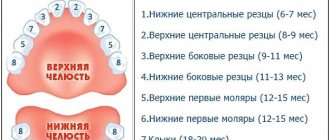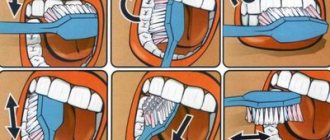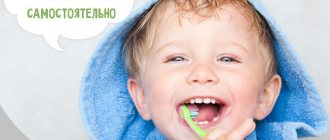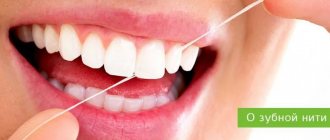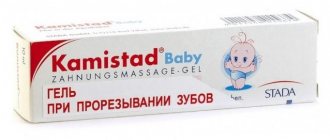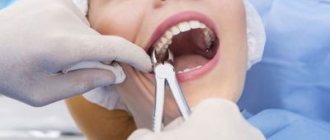At all stages on the way to growing up, a child’s body goes through a lot of crises and undergoes many changes. Experts call the appearance of the first teeth one of the global changes. This is a sign that soon the baby will begin to switch to a different type of food and begin to learn to care for his teeth on his own.
Like any fundamental change, the teething of the first teeth is shrouded in myths and folk “advice,” fears and prejudices. However, not all of them are groundless. Serious changes in a child’s body are noticeable even to inexperienced parents; the teething process can be predicted and greatly facilitated.
Experts identify a number of main symptoms of the appearance of first molars, namely:
- baby's irritability;
- sleep disorders;
- swelling, redness of the gums in the place where the tooth is cut;
- disturbances of appetite, attempts to completely refuse to eat due to the fact that this process causes discomfort to the child;
- increased salivation (and, as a result, a rash on the chin);
- watery eyes;
- the child’s attempts to constantly gnaw or bite something to relieve itching in the gums.
Additional symptoms of teething include:
- slight and short-term increase in body temperature;
- small hematomas in the place where a new tooth plans to appear;
- child's cough (also short-term);
- loose stools (occasional);
- vomiting (clean, due to the fact that the baby swallowed saliva);
- runny nose.
If additional symptoms appear complexly and for a long time, this is a reason to contact a specialist!
Many doctors say that a runny nose when a child’s first baby teeth erupt is absolutely normal. It can manifest itself for several reasons:
- irritation of the nasopharyngeal mucosa;
- allergic reactions;
- mild colds due to decreased body immunity;
- a large volume of saliva that enters the nose.
Despite the fact that teething in general is not a very pleasant process, both for the child and for the parents, the appearance of a runny nose during this period greatly aggravates the situation. The baby does not understand what is happening to him, becomes even more capricious and restless, he needs to pay even more attention, and rinsing and cleansing of the nose is also added to the daily procedures. But the good news is that a runny nose during teething is a normal physiological reaction. In addition, it helps to notice the appearance of a tooth and goes away within 3 days.
Runny nose in a baby during teething: main causes
Almost everyone will have painful teething, this situation cannot be avoided. But knowing the symptoms and the reasons for their appearance, parents can make life much easier during this difficult period for both themselves and their baby.
Let's take a closer look at why many children also develop a runny nose when their first teeth appear.
The mucous membranes of the nose and mouth are located quite close. Due to the fact that mild inflammation begins in the mouth, the nasal mucosa is also irritated. The body reacts to this instantly, starting to produce phlegm (“snot”) in order to calm the irritation or get rid of what may be causing it.
In addition, increased irritation of the nasal mucosa occurs due to the fact that blood enters both the nose and mouth through the same arteries. Blood circulation in the oral cavity during teething becomes more active, and the same processes occur in the nasal mucosa. And the more active the blood circulation, the more mucus the mucosal glands will produce.
A runny nose may occur due to a mild cold. It is during the period when the first teeth are cut that the first complementary foods are introduced, the dose of breast milk is reduced, and the body undergoes restructuring. Also, the baby constantly tries to chew something to relieve itching from the gums, and the path for viruses and microbes into the small body is open. Fortunately, the baby has enough resources to fight off a cold. A slight runny nose is its residual effects.
It is precisely because of reduced immunity and changes in the child’s eating behavior that a runny nose can also signal allergic reactions. At the same time, it is important to monitor whether the child has any other manifestations of allergies. You should be alerted to a rash, itching, and redness of the mucous membranes of the eyes.
If the baby remains active during the teething period, it is likely that due to his active movements, part of the saliva, which is secreted more than abundantly during this period, ends up in the nose. And it comes out of it in the form of transparent, light snot.
How to distinguish normality from pathology
| Symptom | Norm | Pathology |
| Cough |
|
|
| Runny nose | Often occurs against the background of the eruption of fangs and incisors (“eye teeth”): the secretion secreted from the nose is always transparent and liquid, reminiscent of water | The secretion from the nose was only liquid and transparent at first, but after 1-3 days it thickened, the snot became yellowish or green. Nasal congestion appeared. |
| Temperature | 1-2 days before teething, the temperature can rise to 37.5-38 degrees. Easily removed with antipyretics. | High fever is difficult to control with medications such as Nurofen and Ibuprofen and increases quickly. |
| Vomiting and diarrhea | No vomiting. Diarrhea can be observed for several days, but no more than 2-3 times a day. | May be. If vomiting is accompanied by diarrhea, it indicates the appearance or addition of rotavirus or intestinal infection. |
When teething, a large amount of saliva is released, which flows from the mouth onto the baby’s chin and lips, and the skin around the lips becomes irritated and reddened from constant humidity, and a rash may even appear on it. You also have to change the baby’s clothes almost every hour, because the baby’s entire chest is also covered in drool. All these are signs that the cough is not a symptom of pathology or a serious illness. In this case, there is no reason to panic, just do not forget to wash the child’s face with water more often and remove drool with a handkerchief. Use ointments and powders to relieve skin irritation.
According to some famous doctors and pediatricians, coughing on teething teeth can occur either wet or dry. Most often, it appears after the baby has been crying for a long time, as a result of which breathing becomes difficult and the throat becomes dry and sore, which is why the so-called “cough reflex” develops. In particular, Dr. Komarovsky shares this opinion.
You may also be interested in
CHILDHOOD
Finger wipes from 0 to 3 years ASEPTA BABY
For gentle oral hygiene of babies and massage of gums during the eruption of the first teeth
More about the product
CHILDHOOD
Children's gel toothpaste from 0 to 3 years ASEPTA BABY
Designed for gentle care of baby's gums and baby teeth
More about the product
Don't rush with complementary foods
As you know, a child’s first molars begin to appear at the age of 6 months. This period in life is also associated with a change in eating habits. It is important that during this period complementary foods are not introduced abruptly or in large quantities - this is a stressful situation for the child, which will provoke a decrease in immunity.
In addition, at the same time, a change in “antibodies” occurs in the baby’s body. While in the womb and in the first months of life, the child’s immune system “works” with the help of antibodies from the mother’s body. And it is at six months that “maternal” antibodies begin to be replaced by “own-produced” antibodies, and the fragile immune system may not cope on its own.
If your baby's teething process is painful, delay introducing solid foods. Remember that breast milk meets 90% of a baby's needs up to the age of 1 year.
Monitor air humidity and take walks
If several teeth are cut at the same time or one by one, then a runny nose can last for a week. At the same time, if the color of the discharge does not acquire a pathological shade characteristic of infectious diseases, there is no need to be overly nervous about this. If there is no fever and the child is alert, he can be bathed.
If you have a runny nose due to the first teeth, fresh air and maintaining normal humidity in the room help. Frequent airing and walks in nature will help ease this period for the baby.
Use medications only when absolutely necessary
In such situations, taking strong medications should be avoided. Including those that affect vascular tone. The small body quickly gets used to them and in the future will not be able to cope with breathing without the constant use of medications. In critical cases, the use of vasoconstrictor drugs is allowed for 6 days, no more. In addition, they must be with a strictly “children’s” dosage of the active substance and used in the dosage prescribed by the doctor.
To relieve general pain syndromes, children are recommended to be given anti-inflammatory and antipyretic drugs. They will help get rid of unpleasant sensations, but, alas, will not affect the abundance of phlegm.
Cleaning baby's nose
You can remove mucus yourself, using baby syringes or nasal aspirators, which are produced, for example, in the shape of funny animals and will not scare the baby; on the contrary, they will make the procedure of cleaning the nose fun.
In addition, syringes and nasal aspirators have different operating principles. If, with the help of the first, a certain solution is poured into the spout, and then it is removed from the nasal sinus, then nasal aspirators gently suck out excess mucus without causing the child any unpleasant sensations. They are mechanical and electronic.
In addition, to clean the sinuses, you can use thick cotton or gauze swabs or special wet baby wipes rolled into thick soft tubes.
You need to get rid of snot several times a day, in a way convenient for you.
However, experts do not recommend using sprays to clean the nose, since in children they can cause spasms of the vocal cords or simply scare the child.
At the same time, while getting rid of mucus from one nasal sinus, the second one must be carefully closed. It is better to clean the nose periodically so that the snot does not irritate the throat or get into the bronchi, maxillary sinuses or ears.
The cleansing process may not always be pleasant. Delicate mucous membranes will react sharply to it - with coughing reactions or even nausea. But after 3-4 procedures, if there were any negative reactions, they will disappear.
Basic rules for dealing with a runny nose during teething in a baby
The process of the appearance of new incisors and molars is not always accompanied by a runny nose. For many parents, this process can go unnoticed. Experts have come up with several “general” rules, the observance of which is useful for the child as a whole, but during such a runny nose it will make life much easier for both the baby and adults:
- Walks in the open air. The more time a child spends outside, in comfortable conditions, the easier it will be for him to breathe. Even in the cleanest house there is dust and similar irritants that aggravate a child's runny nose.
- The air temperature in the house should not be lower than +17 or higher than +22.
- The air humidity in the children's room should not be lower than 55% or higher than 75%.
- Gently remove mucus from the baby's nose. Make sure that the mucous surfaces are not overdried.
- Monitor the type of discharge. If they are opaque and thick, this is a reason to worry.
- Give the child a lot to drink to compensate for the loss of moisture (excessive tears, snot, salivation reduces the level of water in the body, and this can lead to drying out of the mucous membranes, an increase in temperature and the onset of inflammatory processes).
- Keep calm. If a runny nose is not a symptom of a disease, then it will go away on its own. You need to come to terms with it and only make this period as easy as possible for the baby.
Prevention of runny nose and cough during teething in a child
There are no specific measures to prevent these unpleasant symptoms. However, following general hygiene and feeding recommendations will help keep your baby's body healthy and able to resist infection.
Recommended:
- Exclusive breastfeeding up to 6 months.
- If the child is bottle-fed, it is also not recommended to introduce complementary foods before six months.
- Gradual introduction of complementary foods focusing on the baby's nutritional interest.
- Maintaining the child’s personal hygiene, including oral hygiene. Asepta Baby finger wipes are great for this, helping to remove food debris and plaque from the baby’s gums and teeth.
- Correct daily routine, walks in the fresh air, cleanliness of the room and maintaining an optimal microclimate.
These rules will help support the child’s immunity, so that he can better cope with difficult trials for him, such as teething.
We hope your baby's teething process is painless and you get a good night's sleep. And if unpleasant sensations still bother your baby, ASEPTA BABY finger wipes for 0 to 3 years will help provide a gentle massage and relieve gum pain. Impregnation with plant extracts prevents inflammation and allows you to maintain the acid-base balance of the oral cavity.
In what cases should you consult a doctor?
Until the child leaves infancy, the pediatrician should be informed about all changes in his health and behavior.
You should visit a doctor as soon as possible if:
- cough occurs in attacks;
- accompanied by audible wheezing;
- purulent sputum is rejected;
- the child refuses to eat and drink;
- temperature rises beyond 38℃;
- antipyretics do not help;
- Vomiting or severe diarrhea occurs.
You need to visit the pediatrician again if the cough and other signs of teething do not disappear for more than 6-7 days. A child may get sick after symptoms appear, and parents will think that it is because of the teeth.
How to treat physiological and pathological cough
Doctors advise first of all to relieve pain caused by a growing tooth. For this purpose, gels with lidocaine and soft teethers are used. You can massage the gums and distract the child with games.
Teethers and lidocaine gels help reduce gum pain in children
The teether distracts the baby, accelerates tooth growth, and massages the gums. Lidocaine relieves pain. These therapeutic measures help prevent prolonged crying, improve the baby’s sleep and appetite. Before buying a gel with lidocaine, you need to consult a dentist, since not all gels are suitable for infants. Some products have a high concentration of lidocaine, which is dangerous for the baby.
The physiological cough reflex does not need to be treated. It goes away on its own. Pathological cough requires the prescription of not only antitussive and expectorant drugs, but also antiviral or antibacterial drugs. Before starting treatment, you should consult your pediatrician. He will determine the cause of the disease and prescribe appropriate therapy.
If the pathological cough is wet, it is better to use mucolytic agents. Mucolytics gently liquefy mucus and promote its removal. A dry cough caused by the disease is treated with antitussives. They help reduce attacks of the cough reflex, especially at night.
If your baby develops snot while teething, it is necessary to rinse the nasal passages with saline solution. To do this, just drop 1 drop of 0.9% sodium chloride into the nasal passage, and then use a special syringe to suck out the mucus along with the solution. There should be 2-4 washing procedures per day.
Pressurized saline sprays should not be used to rinse the nose of children. Strong pressure of liquid can frighten a child. Large amounts of liquid lead to choking or choking.
What parents need to do
First of all, parents must understand that at the time of teething, the child’s body is weakened, and therefore vulnerable to various types of infections. And the baby must be protected from them: avoid contact with sick people, watch what the child puts in his mouth, and maintain hygiene. And, of course, carefully monitor the child’s well-being, since the same runny nose, cough and upset stomach, depending on the degree of manifestation, can be either normal symptoms of teething or the result of a disease.
If you have a cough
- Give your baby a cool teether.
- Try massaging your gums.
- Raise the baby's head so that phlegm flows down his larynx, he does not choke on it, and this, in turn, would not lead to coughing.
- Using a pipette, drop a bactericidal property into the child’s nose or, as an easy alternative to this, a decoction of medicinal herbs. This will not only prevent the accumulation of sputum, but also prevent the mucous membrane from drying out.
Optionally, you can give your baby immunostimulating drugs that will help cope with the weakening of the body. But only a pediatrician can prescribe these drugs; self-medication is not only harmful, but even downright dangerous.
If you have a runny nose
To prevent the child's breathing from becoming difficult, excess mucus should be removed with a nasal aspirator or a syringe bulb. And to protect the mucous membrane from drying out and softening dried mucus, it is effective to wash and moisten it with clean water or saline solution (the latter has a disinfecting effect).
Sprays for runny nose and nasal congestion are described in this article.

